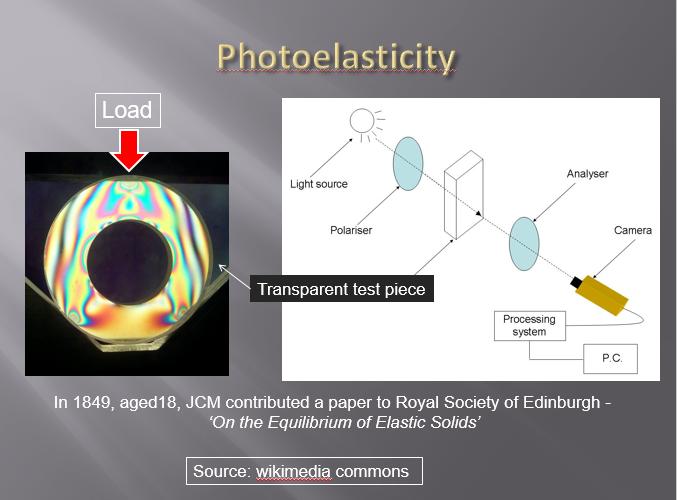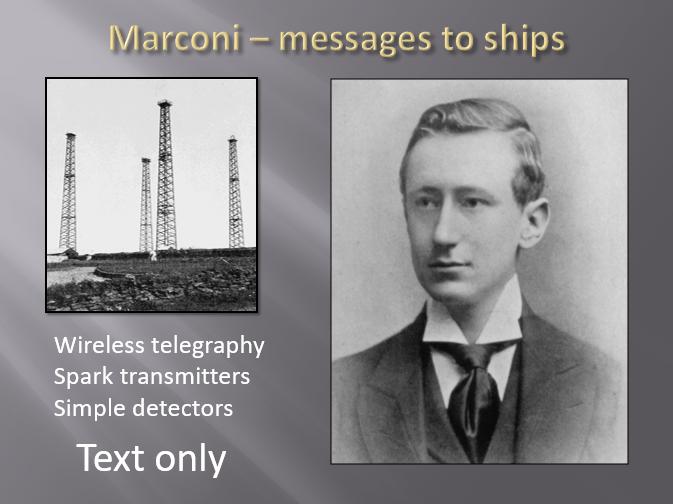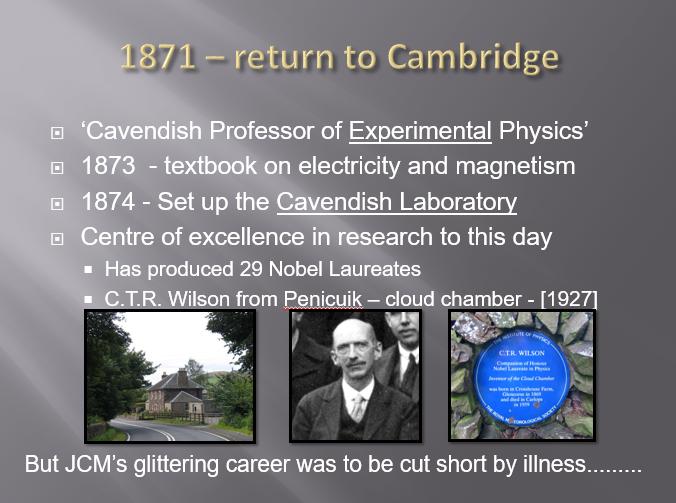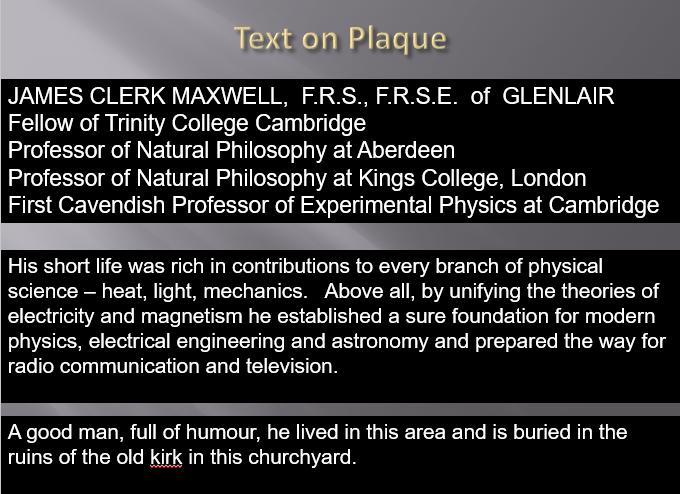
Our good friend Prof Tom Stevenson, Chairman of the Museum of Communication in Burntisland, presented “James Clerk Maxwell” with musical interludes at the LRS meeting on 8th February 2017 at the Braid Hills Hotel.
Tom expressed his thanks to Andy and Flora Munro for their contributions to the music CD which was played at many places during the presentation. Andy was responsible for setting JCM’s poems to music and for the musical arrangements.
The titles of the poems include the one that is sung to the ‘Air of Lorelei’, ‘Valentine to a Telegraph Clerk’, and ‘I’ve heard the Rushing’.
The song James Clerk Maxwell is available on this site: CLICK.
All of Maxwell’s poems are available at: https://www.poemhunter.com/james-clerk-maxwell/poems/
 Tom’s slides are reproduced here with his permission in a shortened version of his presentation, with notes added where necessary.
Tom’s slides are reproduced here with his permission in a shortened version of his presentation, with notes added where necessary.

This presentation has been given before several times, including at the Orkney Science Festival and also in Penicuik, the home of James Clerk Maxwell.

Maxwell’s work has had a huge impact on our lives – think of broadcasting, wireless communication, television, digital photography,……….and even at the level of sub-atomic particles some of his ideas are still relevant today.


One of the slides accompanying the many musical interludes, set at Glenlair in Dumfries & Galloway.

Maxwell’s birthplace at 14 India Street in Edinburgh is now owned by the Clerk Maxwell Foundation and contains some of his apparatus, confirming that he was a practical experimenter. For more information go to:
http://www.clerkmaxwellfoundation.org/
 The front room at 14 India Street is now used for exhibitions and displays of Maxwell’s work.
The front room at 14 India Street is now used for exhibitions and displays of Maxwell’s work.

The family moved to Glenlair House in Dumfries & Galloway when Maxwell was very young. There he was home-schooled by his parents and played with other local children, gaining a strong local accent which he never lost.

Maxwell’s mother died when he was only 8.
He would walk in the local woods and sit by the local burn and contemplate.

After his mother’s death his father hired a tutor for James. Unfortunately they didn’t get on and after two years James revolted, climbed into a washing tube and pushed off to the middle of their pond. The tutor was duly ‘let go’.

Unable to find the time to teach James himself, his father sent him to Edinburgh Academy where he lived with relatives. His Galloway accent and home-made clothes resulted in him being mocked and bullied by other boys, who called him ‘Daftie’, but by the age of 13 he shone academically, including having a paper accepted by the Royal Society of Edinburgh..

Among James’s inventions was the replacement of the slits in a Zoetrope by lenses, giving a much brighter image.

James wrote an irreverent School Song while at the Academy.
The modern Science Centre is named after him.

James went to Edinburgh University at age 16. He set up his own laboratory and workshop in the washhouse at Glenlair, building batteries and working with chemicals but was fascinated with light and polarisation effects – discovered photoelasticity – paper to Royal Society.
In 1850 he went to Cambridge to continue his studies and research. There he met William Thomson [Lord Kelvin] whose ideas on heat conduction would later inspire him in his work on light waves.

JCM used a jelly as the transparent model to demonstrate the effects of strain on the transmission of polarised light.

Faraday had shifted attention from the magnets and charges themselves to the space between them. A magnet, he said, is not just a lump of iron, but the centre of a system of invisible curved tentacles, reaching out through space to draw in or to repel other magnets. He called these tentacles lines of force, which covered the whole of space with a field.
JCM set out to read and understand all of Faraday’s experimental results before he undertook the challenge to express these ideas mathematically, in 3 dimensions. [I wish those who try to model the real world in software today would do the same!] His background in spatial thinking – remember the ‘hedrons – served him well and in 1855 he published a paper on the subject.
While JCM’s research career was developing he had a personal set-back; he had fallen in love with his cousin Elizabeth while on holiday in the lake district. Unfortunately, the families decided that cousins should not marry and each was to marry someone else. For Maxwell, the autumn of 1854 turned into bleakness. He expressed his thoughts in a poem. These words were not reviewed and ‘polished’ later – they are exactly as they came to him.

James’s father died at Easter 1856 and shortly thereafter James moved to Marischal College as Professor of Natural Philosophy.
He worked on the structure of the rings of Saturn – 80 page essay => Adams Prize – and on the kinetic theory of gases and made great advances in his research. His teaching included practical demonstrations, often using specially constructed apparatus.

His teaching methods had ruffled a few feathers among the parents of students. Maxwell insisted that students had to carry out the practical work in person and banned their ‘manservants’ from doing the work in the labs on their behalf! Student opinion on his teaching seems to be ‘mixed’ with those who were interested in the subject finding his lectures stimulating – nothing changes! He also ran evening classes for the general public while in Aberdeen and these were well attended.
A favourite demonstration, as recalled by a farmer, was the mounting of a member of the class on an insulated stand while Maxwell “pumpit him fu o’ electricity so that his hair stood oot on end.”

But in 1860 the two Aberdeen colleges merged and there would be only one Prof of Nat. Phil. The chair was awarded to ‘Crafty Thomson’ instead of Maxwell. The chair at Edinburgh University became vacant and he applied for it. However, his great friend from schooldays, Peter Guthrie Tait, was preferred over him, although this made no difference to their lifelong friendship. Then King’s College London also needed a professor, and Maxwell was chosen.

JCM had built apparatus and made quantitative measurements of the eye’s colour response while in Aberdeen. Photography was progressing rapidly and he collaborated with Thomas Sutton at KCL on ways to reproduce colour using the [monochrome] silver halide emulsion plates which were available.

This is a contemporary illustration but he may have used 3 separate lanterns. Note that the electric light bulb had not been invented so the light source would have been paraffin or gas – limelight. Sutton would go on to invent the single lens reflex camera.
This demo should not have worked as plates were not sensitive to red – but there was UV in the tartan image………long story

We return to the electric and magnetic fields with their lines of force in a static situation. What if the charges were moving or vibrating? William Thomson had shown that heat conduction behaved as a wave [sound vibrations] so could vibrating charges generate waves? If a charge is vibrating, the lines of force are vibrating and any other charge in that field will experience an undulating force. Another charge further away will experience a lower force, perhaps with a time delay and to an observer it will appear as if there is a transverse wave travelling in space, as a distortion of the electric field. But what about the magnetic field? It was already well known that an electric current – a flow of charge – creates a magnetic field at right angles to the flow. Faraday was already familiar with this and had used it to great effect.

Current in a wire deflects a magnetic compass needle; reverse the current and deflection reverses. So our vibrating charge is really an alternating current which will generate an alternating magnetic field at right angles to the movement of the charge.

JCM then realised that if there was an undulating electric field there should be an corresponding undulating magnetic field and he expressed these dynamic fields mathematically in three dimensions. Originally he had 20 partial differential equations with 20 variables, later simplified to just 4 equations. He calculated the speed at which such electrical and magnetic phenomena should travel from the known physical properties of space and came up with a value close to the speed of light.

These words were very well chosen and it shows that he realised the spectrum was very wide, well beyond the rainbow.

Maxwell showed that visible light was part of a wide spectrum of electromagnetic radiation. Oscillating charge in a circuit would lose energy as radiation with a wavelength [lambda] given by C = F. Lambda, where C is the speed of light. Frequencies in the order of 1Mc/s would have wavelengths around 300m

This was demonstrated by Heinrich Hertz over a distance of a few metres but he said he could not think of any practical use for this phenomenon…..but Marconi saw the potential benefit of extending the electric telegraph to shipping – without wires – and the rest is history! But it required technology such as the thermionic valve to realise its potential.

And certainly electricity and magnetism were to the fore in Victorian Britain, with the electric telegraph becoming a feature of life. It has been described as the Victorian Internet. Maxwell looked cheerfully at how one telegraph clerk might send a Valentine message to another.

The output of Marconi’s spark transmitter was in the order of kilowatts and the range could be typically hundreds of miles, sometimes thousands under ideal conditions. Rapidly applied to shipping. The receiver detector was a ‘coherer’ – electronic amplifiers were not available yet.

Maxwell returned to Cambridge in 1871 as the Cavendish Professor of Experimental Physics. Money for this post and the new Cavendish Laboratory building had been donated by Henry Cavendish, Duke of Devonshire.
Charles Wilson, who invented the Cloud Chamber for detecting atomic particles, was also a farmer’s son from Crosshouse near Penicuik. The blue plaque can be seen in a wall near the Flotterstone Inn.

In 1879 JCM was diagnosed with the same type of cancer as had taken his mother almost 40 years before. He and Katherine spent the summer at Glenlair and then returned to Cambridge in the autumn.
As death approached Maxwell told a Cambridge colleague
I have been thinking how very gently I have always been dealt with. I have never had a violent shove all my life. The only desire which I can have is like David to serve my own generation by the will of God, and then fall asleep.
He died in Cambridge on 5th November 1979 at the early age of 48. As was his wish, his body was brought home to Glenlair and was buried beside his parents in the kirkyard at the village of Parton nearby.

His grave at Parton has a very plain headstone which makes no mention of his scientific qualifications or his career.

But on the green beside the war memorial there is a plaque to Maxwell, erected in 1989.


How has Maxwell’s work been on benefit to mankind? The modern mobile phone uses Maxwell’s waves for communication and also uses much of his work on colour vision and colour photography to capture and display images – a global success story! We can now talk to anyone, almost anywhere on the planet at any time.
So, whenever you use your smartphone, take a photograph or watch television – remember and give thanks to the boy from the Galloway hills who walked in the woods by the water and went on to make one of the greatest leaps in human thought, 150 years ago – James Clerk Maxwell. And now for our closing song…….
